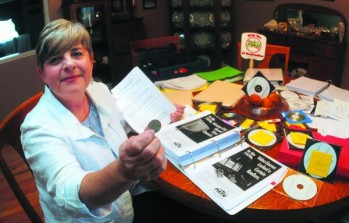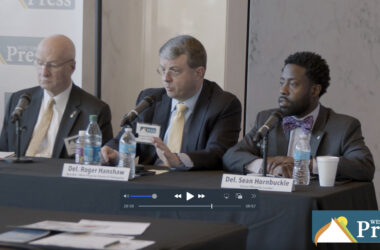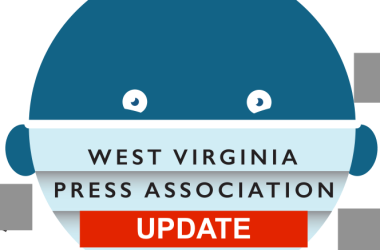
Keryn Newman in her dining room filled with paperwork fighting against The Potomac-Appalachian Transmission Highline (PATH), a proposed 290-mile 765-kilovolt electric power transmission line designed to supply more power to the region holds up a nickel, about all the money she has been able to recoup after the U.S. Federal Energy Regulatory Commisison’s Initial Decision was released last week.
SHEPHERDSTOWN, W.Va. — Keryn Newman finally has a minute to herself.
Time was hard to come by during the past several years she spent battling developers of the controversial Potomac-Appalachian Transmission Highline Project – more commonly known as PATH -even after they abandoned the project.
But it was a good investment, especially since her most recent efforts were largely responsible for a federal administrative law judge’s decision that the electric utilities behind PATH can’t pass off certain costs on their customers – an estimated $6 million in savings to the public.
It was a long, difficult and time-consuming battle – not unlike David and Goliath, according to some comparisons-but hindsight has shown this was the right thing to do, she said, still vividly able to recall the massive amount of self-education required to even begin fighting the utilities.
While citizen activists in West Virginia and Maryland were happy the proposed 765-kV power line was no longer being considered, Newman still wasn’t satisfied because ratepayers were not yet off the financial hook because the utilities wanted them to be responsible for a hefty bill consisting of project- related costs.
Despite no longer being viable – it was set to run from American Electric Power’s John Amos coal generator in St. Albans, West Virginia to New Market in Frederick County, Maryland – AEP and then-partner Allegheny Energy (now FirstEnergy) didn’t want to foot approximately $6 million for project costs that included lobby and advertising, as well as some legal and property acquisition costs.
No stranger to the original proposal, Newman first got involved after learning about homes that would be lost to the construction project – as well as what seemed like a lack of need for it.
Other folks were equally opposed, but didn’t seem to know how to advocate against it, said Newman, recalling one particularly compelling time when an elderly woman was almost begging for help in stopping the line because it would destroy her son’s property.
“Someone clearly had to do something,” she said without hesitation.
A self-described mother and wife, Newman, who had no legal training, relied on her experience working in an accounts receivable job to begin to “follow the money and numbers” while taking on the regulatory system.
In the end, another homemaker-turned-activist, Roane County resident Allison Haverty, joined her as a party to litigation at the Federal Energy Regulatory Commission and the duo spent “almost countless hours” preparing for this complex legal battle, which officially got underway in March in Washington, Newman said.
As pro se intervenors, the duo represented themselves during the procedures – without the aid of an attorney.
“Our goal was to seek a refund of just over $6 million that PATH collected from ratepayers via federal transmission rates to finance the cost of its public advocacy-building and lobbying activities. My contention (and coincidentally the contention of the FERC staff assigned to the case as well, as it turned out) was that FERC regulations and accounting guidance prohibited the recovery of the cost of these kinds of activities,” Newman said.
Some of the most objectionable expenditures, from 2009-2011, involved the companies’ contracting for various public relations firms and other companies to produce advertising, to form public coalitions, lobby politicians/policymakers and to conduct other advocacy activities intended to support the transmission lines construction, she said.
The two women took issue with the millions of dollars that had been spent on everything from general advertising ($2.6 million) to the establishment of pro-power project groups like the Reliable Power Coalitions ($1.5 million) and PATH Education and Awareness Team ($1.4 million), Newman said.
Their legal position didn’t fall on deaf ears, and in a Sept. 14 decision, administrative law judge Philip C. Baten agreed with the activsts’ contention that the public should not be responsible for paying these costs.
“Utilities should rely on the established governmental approval processes to persuade the officials and not indulge in collateral efforts such as public education, outreach and advertising activities,” the opinion stated.
“If a utility should rely on these collateral activities, then it will risk the chance that these costs may not be recovered from ratepayers. If the selection or application has merit, the governmental selection process provides a sufficient vehicle for the utilities to present their engineering, marketing and economic studies and thereby hope to merit the vote of approval from these officials,” it continued.
FERC commissioners still have to decide what will happen next, and it’s also possible that corporate officials will decide to appeal any decision, Newman said, adding that she is still buoyed by this most recent success.
“Despite all of the time that went into this, and times when my husband barely knew he had a wife, I never doubted this is something I had to do. And even given what I now know, I would do it all over again,” she said.
Staff writer Jenni Vincent can be reached at 304-263-8931, ext. 131, or www.twitter/jennvincentwv.com.





